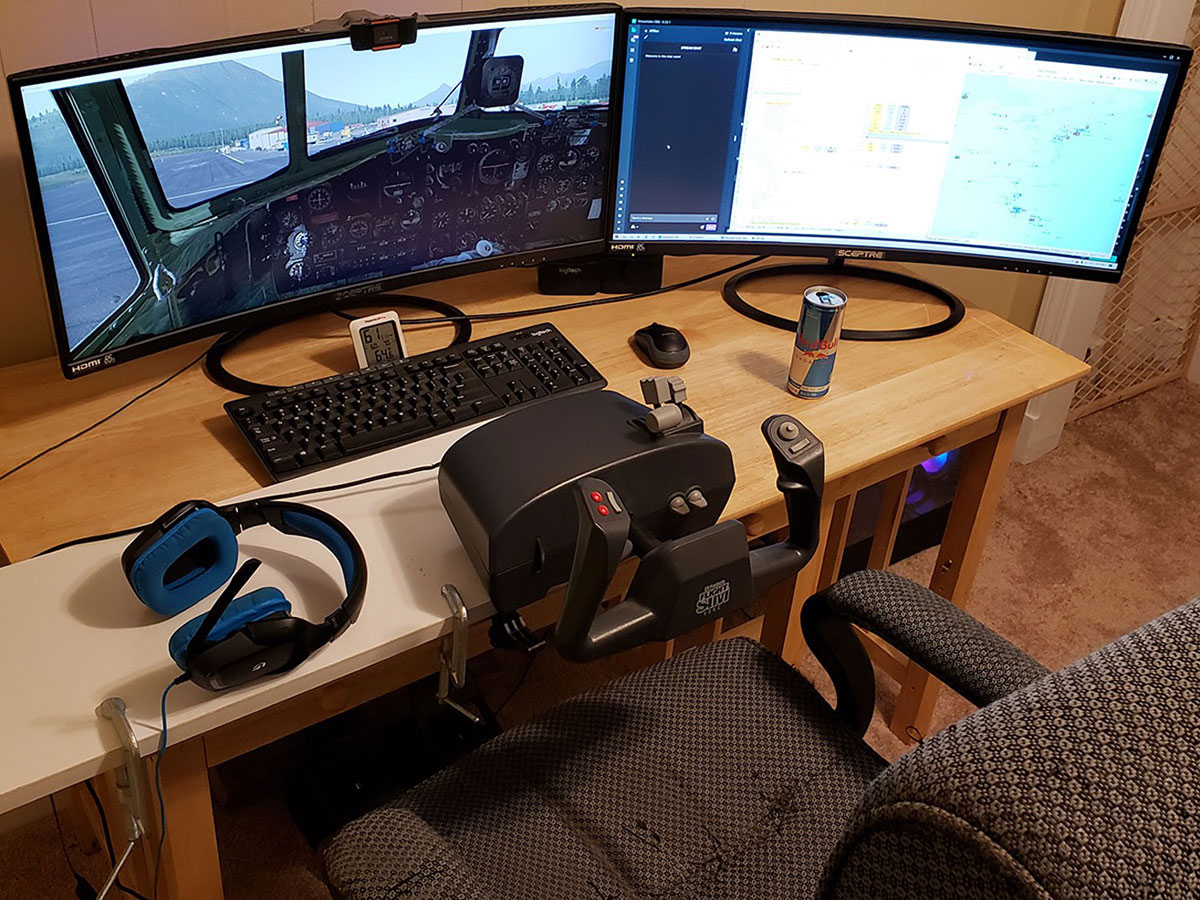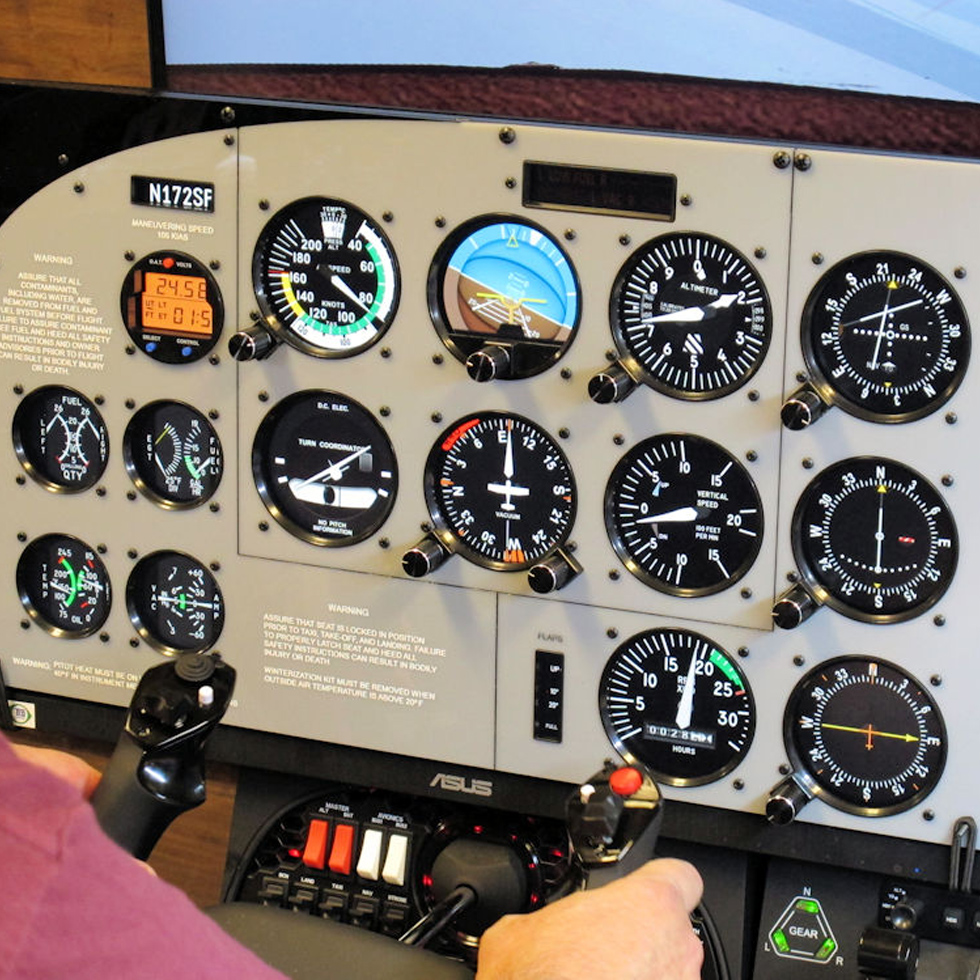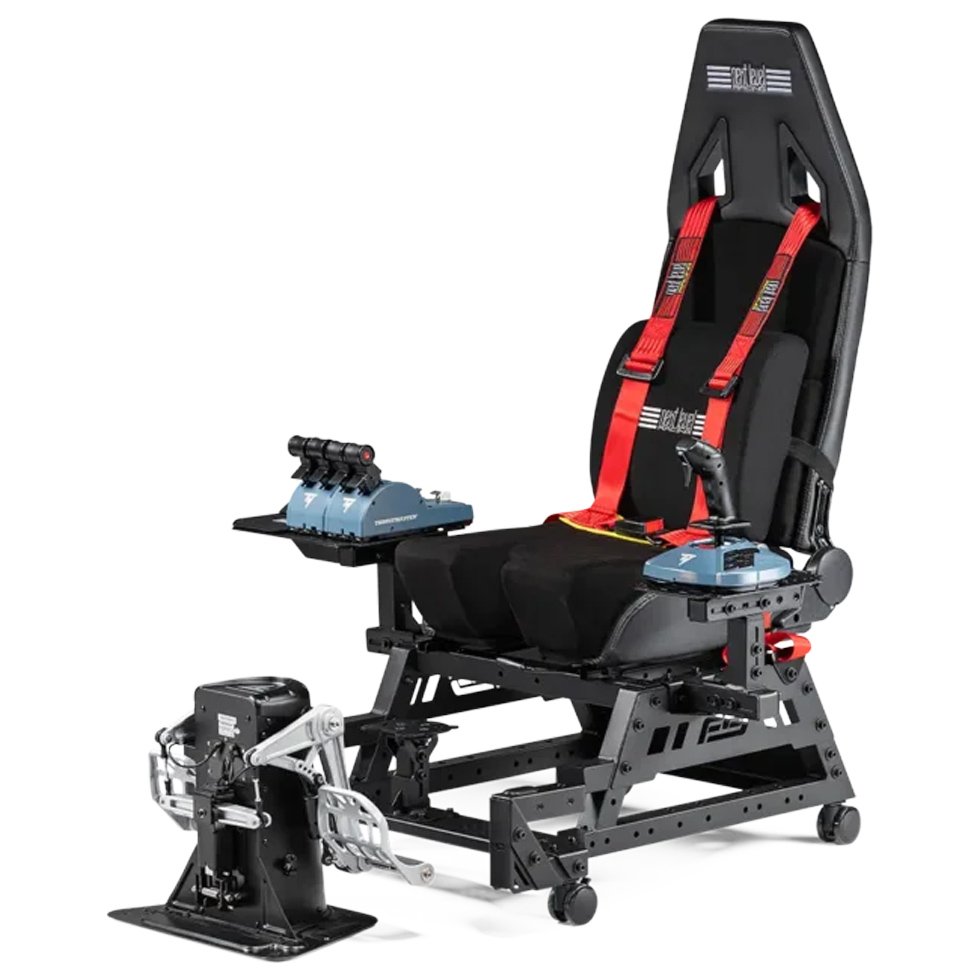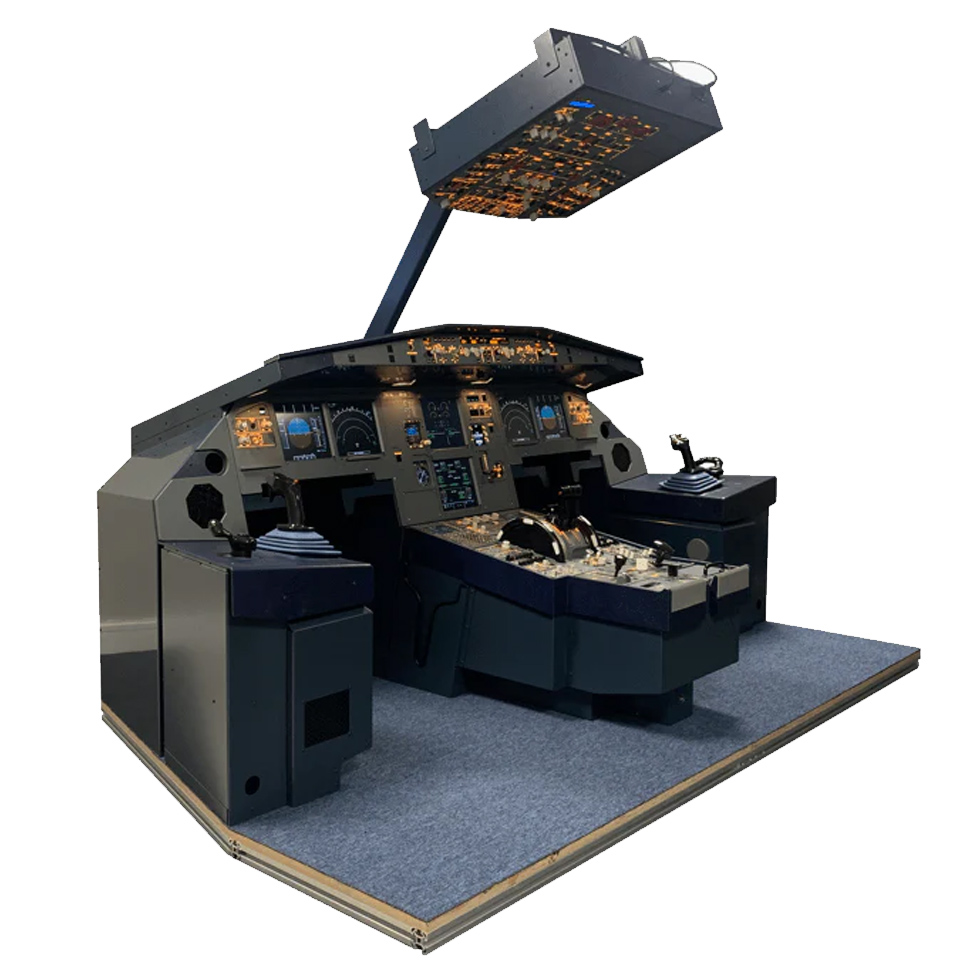Hardware
Learn About Hardware Additions to your Setup
Introduction
Although it’s possible to control desktop flight simulators using a mouse and keyboard, most simmers purchase add-on hardware to make the experience more realistic. From yokes and joysticks to throttle quadrants and beyond, there’s hardware available that will allow you to truly make your sim your own. Some simmers even go to the lengths of building full-size cockpits in their homes, sheds, and garages!
Advice for Beginners
A good rule of thumb in flight simulation is to start with the basics and build over time. This guideline is particularly true with hardware, which can become very expensive very quickly.
If you’re a newcomer, start simple by investing in either a yoke or joystick, and perhaps a set of rudder pedals. Continue reading for specific hardware recommendations within these categories. After making an initial hardware purchase, relax and enjoy flying your simulator! Spend some time learning what type of flying you like to do and what you’d ultimately like to get out of your setup. Then, if it makes sense, consider adding to your setup with some of the more advanced options discussed in this guide.
A challenge with hardware is that each piece of equipment works and feels a little differently. Therefore, it's best if you can find a way to "try before you buy". Live events like FlightSimExpo are ideal for evaluating multiple types of hardware, as you’ll find a variety of demonstrations all in one place.
As you review this guide, be thinking about:
Flight Controls
Consider a yoke if the aircraft you fly are mostly controlled by a yoke, and if it fits well in the space you have available on your desk.
Consider a joystick for a more flexible setup. Joysticks often have built-in throttle and/or rudder controls, thus reducing the need to for additional hardware, and generally fit in a smaller space.
If yaw control is important in your setup, rudder pedals are a great enhancement for improving the overall experience.
Type of Material
Plastic controls tend to be cheaper and more widely available but may not last as long and tend to offer a less realistic feel.
Metal and other controls have a heavier and more durable feel.
Placement
Where will your controls go? If you plan to mount a yoke to your desk, where will your keyboard go? Do you have space for a joystick beside your mouse?
Can you place a piece of carpet under your chair or desk to prevent movement while operating rudder pedals?
Flight Controls
This section discusses the basic hardware components that allow you to control the aircraft's movement.
Yokes and Joysticks
Yokes and joysticks are the pieces of hardware used to control aircraft pitch and roll, and they are a must-have for anyone getting started in home flight simulation.
We polled 100 experienced simmers. 99 of them said a new simmer should purchase a yoke or joystick as part of their initial setup.
When purchasing a yoke or joystick, consider which makes sense for the type of simulator flying you think you’ll get into. For example, if you plan to fly military jets, helicopters, or Cirrus or Airbus aircraft, a joystick is normally used to control those aircraft. If you’re a Boeing or Cessna pilot, a yoke is more common.
Also consider your broader setup. For example, a joystick might fit easier beside the keyboard on your desktop, whereas a yoke would need to be mounted to your desk. Additionally, some yokes and joysticks have buttons and switches that are customizable for various aircraft functions. Depending on your use case, such a unit may be more desirable.
Popular yoke and joystick options include:
Honeycomb Aeronautical Products
Honeycomb Aeronautical has produced some of flight simulation's most popular flight control hardware. However, as of March 2024, the company is undergoing an organizational transition and may be unable to offer support or replacement parts.
If you're considering Honeycomb products for your simulator, we encourage you to purchase from a third-party retailer that has the items in stock, like Sporty’s or Aerosoft. Access to direct customer support or replacement parts from Honeycomb may be limited.
Rudder Pedals
Rudder pedals are used primarily for controlling aircraft yaw and for ground steering while taxiing. Pressing the tip of each pedal operates the brakes. Although not strictly required, a set of rudder pedals completes often completes the initial flight simulator setup.
We polled 100 experienced simmers. 50 of them recommended purchasing rudder pedals as part of an initial setup.
Popular rudder pedal options include:
Throttles
Throttle units are typically highly configurable add-ons that control aircraft thrust and a variety of other functions. For example, the Honeycomb Bravo unit pictured below is configured by default for a twin-engine general aviation aircraft, but additional hardware is available that converts it to represent a 2 or 4 engine airliner.
In many cases, throttle units are sold with a yoke, joystick, and rudder pedals in a single “combo pack”. Check with your retailer, as purchasing units in a bundle often results in cost savings.
Because of their versatility and relative cost, throttle units are typically a good “next step” after completing your initial setup.
Popular throttle units include:
HOTAS
The Hands On Throttle-and-Stick, or HOTAS, is a combination unit that includes a throttle, joystick, and customizable buttons and switches. Originally designed for the military, a HOTAS configuration is typically found in fighter jets and helicopters. Although it is less common in airliners and general aviation aircraft, the HOTAS remains a popular hardware add-on in flight simulation because of its compact size and versatility.
Popular HOTAS options include:
Gauges and Avionics
Depending on your interests, you may wish to consider add-on gauges such as avionics panels, GPS units, autopilot control panels, flight managment system interfaces, and more. There are a wide variety of “plug and play” options available across the internet, ranging in price. It’s not possible to discuss every type of add-on available in this guide, but a good place to start is by searching flight simulation stores that sell hardware or dedicated websites like Flight Velocity, RealSimGear, or Simkits. Large online retailers like Amazon carry hardware from some of the major brands, such as Logitech.
Examples of available avionics panels include:
Displays and Visuals
Flight simulation setups often include multiple displays or large screens to enhance realism and utility. Many simmers adopt a configuration where one monitor displays the flight simulator, and a second is used for supporting functions like chart applications or flight planning utilities. A second monitor is certainly not required, but if you happen to have a spare monitor lying around, it might be worth trying as part of your setup.

Example of a basic flight simulation setup where one monitor displays the flight simulator, and a second displays supporting functions like chart applications or flight planning utilities.
Advanced setups commonly make use of large curved displays or multiple monitors, particularly because of their ability to create that “wrap-around” effect of looking out the cockpit window. An in-depth discussion of advanced visuals is beyond the scope of this guide, but the images below from FlightSimExpo provide a sense of what’s possible.
A setup with advanced visuals is a significant investment, so consider your long-term plans and goals for flight simulation first. In general, you’ll need to decide whether traditional computer monitors or 4K/HD televisions are more cost-effective for the setup you’re creating. If you’re purchasing displays specifically for flight simulation, websites recommend at least 1920 x 1080 resolution with a reasonably high refresh rate (120 Hz or better).
Some simmers also use projectors and screens as part of their setups. However, as the price of 4K televisions and monitors has been consistently dropping, these are becoming less popular. If you plan to use a projector in your home setup, ambient lighting and physical space become important considerations. Projector displays can be easily washed out by bright sunlight.
Head Tracking and Virtual Reality
Head Tracking systems allow you to “look around” in the sim naturally. As you turn your head, the camera view in the simulator follows that motion.
Separate from head tracking, more simmers are embracing various forms of Virtual Reality (VR) in their setups. Instead of purchasing a multitude of peripherals, you could instead elect to have a very simple physical setup and spend more time looking through VR goggles.
Most major desktop simulators support both Head Tracking and Virtual Reality. Because of the complexity of both subjects, we have a dedicated guide for those who want to learn more.
Read our Head Tracking and Virtual Reality Guide
Headsets
If you plan to fly online with ATC, or if your setup is located in a “noise sensitive area” of the house, you may wish to consider a headset. Many simmers configure the audio from their simulator (i.e., the aircraft and background sounds) to come through speakers, and use the headset to communicate with ATC. If you’re in a noisy area, you may want everything coming through the headset. In most cases, you can configure sound options from within your simulator’s settings.
If you're a real-world pilot and already own a general aviation headset, it’s possible to purchase adapters to use your headset with a computer. However, you may find your general aviation headset is “overkill” for the home simulator, especially if you have one with Active Noise Reduction (ANR). You might also consider replica general aviation headsets available specifically for the PC, like the T.Flight U.S. Air Force Edition from Thrustmaster.
Most home flight simmers who use a headset tend to purchase one specifically for PC gaming. You can find plenty of options at local stores or online. Search “best PC gaming headsets” and you’ll find plenty of reviews from top gaming publications, with both wired and wireless options. Just remember that if you’re planning to fly with ATC, a boom mic is a must!
Advanced Hardware Setups
This section discusses flight simulator setups that go beyond the desktop. The price point and complexity associated with these setups tends to be higher, but they can offer a much better sense of realism and immersion.
Full Panels
Some advanced setups use panels, like the ones shown below, to help organize displays, yokes, and other hardware elements. These can be purchased as full kits, or as blank panels for you to “fill” with individual gauges and avionics. Fully customized panels are also available depending on your specific requirements.
If you’re thinking about creating a panel setup for your home simulator, there are three options:
Do it Yourself: Lots of simmers that have created setups on their own using locally sourced tools and materials, 3D printed elements, consumer microcontrollers, and more. A home cockpit building website such as Cockpit Builders is a good place to start asking for advice.
Purchase a “Blank” Panel: Flight Velocity produces empty panels that mimic a wide variety of general aviation aircraft. You would then separately purchase your own flight simulation hardware to mount in it.
Purchase a Complete Kit: Some retailers sell complete kits with the panel and gauges, and some also include flight control hardware. Some simmers use these kits as an "all-in-one" solution, while others integrate them alongside their existing setup to enhance realism.
If you're interested in pursuing these types of kits, we recommend starting your research with the following providers:
Altimeter MotivesMember Discount
Flight VelocityMember Discount
RealSimGearMember Discount
Flight Sim Chairs
Specialized gaming chairs, often seen in high-end racing setups, are also popular in home flight simulation. These chairs are specifically designed to enhance immersion by providing an environment that mirrors real-world cockpit seating. Different designs exist based on the type of setup you are trying to create, as shown in the following examples.
Most chair setups focus on modularity and are designed accommodate third-party peripherals, such as control yokes, rudder pedals, and throttle quadrants. For example, a racing-style seat might be modified with additional mounting brackets to accommodate flight sticks and control panels, creating a hybrid setup that's perfect for enthusiasts who enjoy a mix of both flight and racing simulation. Some systems even incorporate motion platforms or vibration motors to further simulate the feeling of flight.
If you're interested in learning more, well-known providers of flight sim and racing chairs include:
SimFabMember Discount
VolairSimMember Discount
Home Cockpits
Those who wish to go beyond desktop mountable hardware or panel kits enter the world of home cockpit building, which is a hobby in and of itself! Home cockpit building is such a vast topic that it isn’t practical to discuss as part of this guide. Instead, we’ll just provide an overview.
Typically, home cockpit building is based around creating a full-size simulator setup from scratch, sometimes using parts from real aircraft. Home cockpit building is about the journey and learning experience, with most builders slowly building their setup over a number of years.
There are entire websites and communities like Cockpit Builders dedicated specifically to this topic, and they are a great place to start. Additionally, a simple Google search will list websites of several home simmers who have built their own home simulator (like this one). These websites are often full of helpful links and great information from people who have already done this!

After 20+ years of desktop simming, passionate home simmer and FSA Member Tony built this Boeing 737-800 simulator.
Not all home cockpits are completely "do it yourself". Some providers offer complete solutions that replicate either complete cockpits or "half cockpits", which typically represent just the captain's seat and associated controls and avionics. While it is possible to purchase this equipment completely configured and ready to fly, expect to pay five or six figures for these setups!
To get you started, well-known providers of large-scale, modular flight controls for airliner simulation include:
SKALARKI ElectronicsMember Discount
Because of the specialized nature of this equipment, companies who provide home airliner setups are located all across the world. As always, do your own research when considering a purchase this significant. In many cases, using companies who are located closer to you will help reduce shipping and import costs.
Hardware Partners
The full suite of flight simulation hardware available extends well beyond the examples on this page. The list below includes FSA Partners who design and manufacturer add-on hardware, and who offer a discount to our members. It is meant to be a starting point in conducting further hardware research.

































































